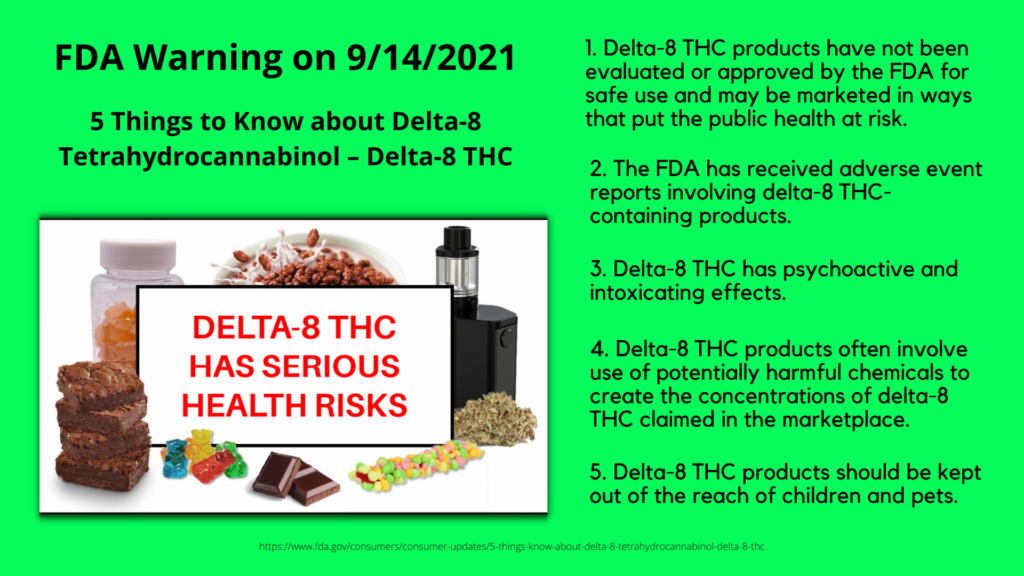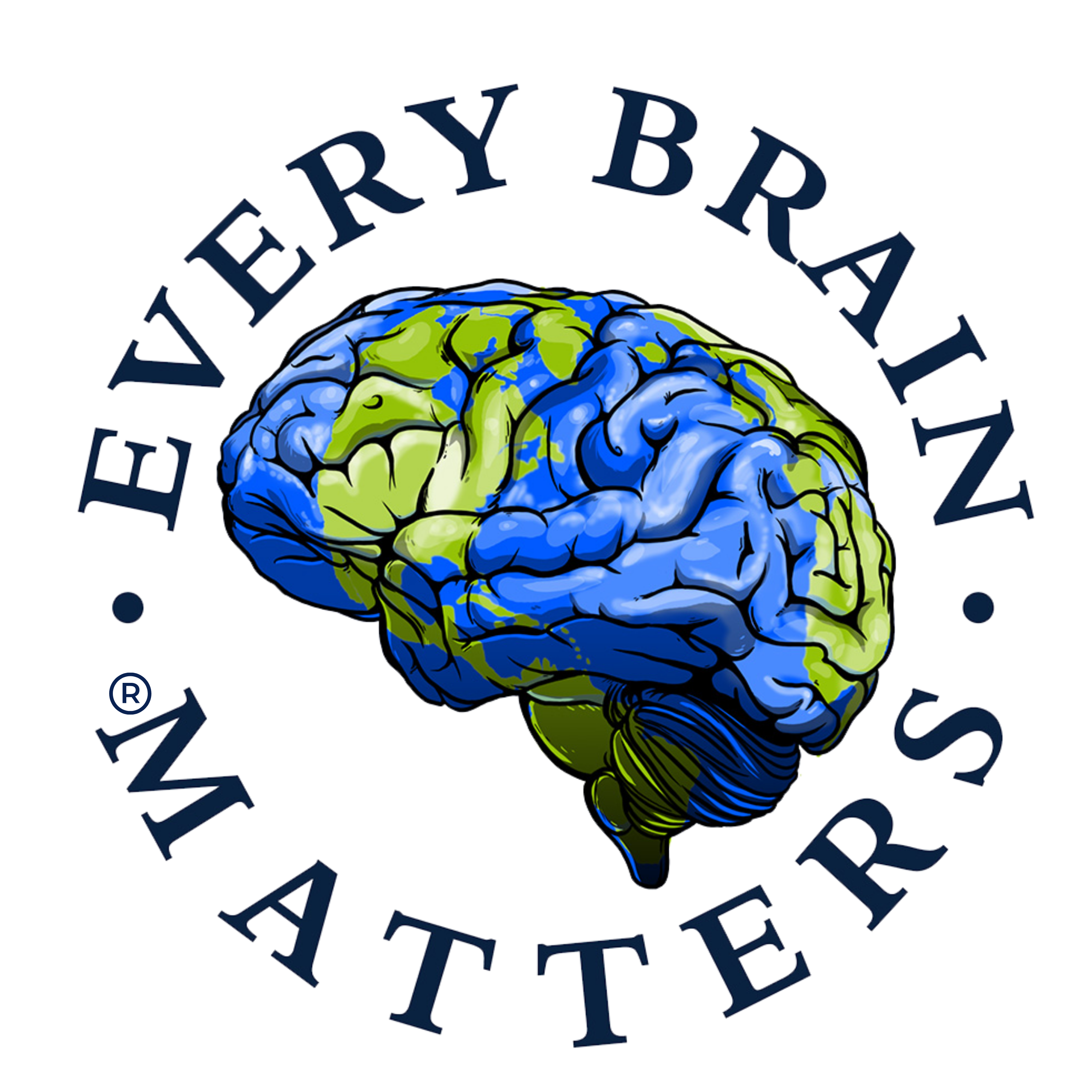Posted on November 7, 2021 View all news
Editor’s Note: This is the first of three papers by Jesse LeBlanc, a mechanical engineer with experience in the chemical industry and member of our Board of Directors. Part 1 covers Delta-8 THC.
Why is the United States passively allowing the manufacture, sale, and use of Delta 8-THC, Delta 10-THC, and THC-O, all of which are harmful chemicals that may be even more damaging than nicotine/tobacco? Why is this happening in a supposedly science-based society? Could this be occurring because of loopholes in the 2018 Agriculture Bill?
Currently, hemp-derived CBD is being synthesized and converted into these chemicals, which are then made into different products for retail sale.1, 2, 3 We can see many of these products being advertised for sale online, in vape & smoke shops, gas stations, and convenience stores in almost every state. These items are even being marketed to children through the use of very inviting packaging and products, such as the all popular gummy bears. Luckily, some state authorities have decided to stop the sale of these products because health officials have identified that there is a potential for serious harm when using these chemicals.
The FDA even recently issued a warning about one of these synthetically produced chemicals, namely Delta 8-THC: https://www.fda.gov/consumers/consumer-updates/5-things-know-about-delta-8-tetrahydrocannabinol-delta-8-thc.
Currently, because CBD is very economical to procure, it is being used as a feedstock to synthesize these mind-altering substances using dangerous chemicals.
- Delta 8-THC1– This chemical is being synthesized using CBD, an acid, and an organic solvent, such as toluene, which is usually used in the manufacture of paint products. This chemical exists naturally in cannabis plants but at very low levels; therefore, it must be synthesized for mass production.
- Delta 10-THC2 – This chemical was discovered by a random accident and resulted from the extraction and distillation of THC from marijuana plants that were exposed to a fire retardant used to combat a nearby forest fire. It too can be synthesized from CBD. This chemical does not occur naturally.
- THC-O3 – This chemical is also being synthesized using not only CBD, an acid, and an organic solvent but by also using a very toxic chemical needed to complete the process. If synthesized from its nearest analog molecule, specifically Delta 9-THC, it can be made by using only the last step, specifically through the use of a very toxic chemical. It is three times more potent when compared to Delta 9-THC. This chemical also does not occur naturally.
The Basic Chemistry
CBD is considered a hydrocarbon molecule comprised of twenty-one carbon atoms, thirty hydrogen atoms, and two oxygen atoms. It can therefore be denoted as C21H30O2. There are other molecules that have the exact same number of carbon, hydrogen, and oxygen atoms, and they are known as isomers.4
Both the Delta 8-THC and Delta 10-THC variants are isomers of CBD. Also, the naturally occurring and psychoactive Delta 9-THC in cannabis plants (hemp and marijuana) is an isomer of CBD. All of these variants thus have the same molecular formula, namely C21H30O2. However, they are different structurally.5
A simple comparison to consider would be through the use of a chemical Lego® block model.6 For an example, a carbon atom could be represented by a red block, a hydrogen atom could be represented by a white block, and an oxygen atom could be represented by a blue block. For the CBD molecule, one could symbolically represent it by connecting twenty-one red blocks (C21), thirty white blocks (H30), and two blue blocks (O2) all together in a manner to represent its structural arrangement. Using the exact same number of blocks, differently shaped models could be made to represent Delta 8-THC, Delta 9-THC, and Delta 10-THC.
In the example above, the CBD building block model would be altered structurally by one’s hands. In the world of chemistry, structural alterations to CBD can be facilitated through the use of different levels of temperature, various catalysts (in the form of an acid), and various organic solvents (such as toluene) into other molecules such as Delta-8, Delta-9, and Delta-10 THC.1,2 There are also by-products formed after the structural transformation along with some residual acid and organic solvent.
In the FDA-regulated pharmaceutical world, the by-products and solvent are removed, and the acid is neutralized. However, few, if any, safeguards exist in the cannabis world because there is no regulatory oversight by the FDA.7
Keep in mind that the manner in which a molecule interacts and affects the human body and mind is dependent upon its atomic makeup, specifically the number and type of atoms present, and its structural arrangement.8 In the case of CBD and its isomers, the way that they can affect the body and mind can be traced back to how they interact with the receptors where they connect. A CBD molecule is molecularly the same but structurally different from the other variants of the THC molecule, hence they can each affect the body and mind in similar and/or completely different ways.
Delta 8-THC – Part 1
Delta 8-THC was first synthesized in 1967 by Israeli chemist Raphael Mechoulam.5 It exists naturally in cannabis plants, but only in very small (normally ~0.1%)1 or in trace amounts.5 There was therefore a need to synthesize the molecule so that it could be studied in depth because of its rarity in cannabis plants.
The passage of the Hemp Bill and subsequent rush to cash in on this crop via the production of CBD has resulted in a glut of this chemical in the marketplace.10 However, it has been known for decades that CBD can be synthesized into other molecules, and one of those molecules is Delta 8-THC 5, which can have reportedly similar but milder mind-altering effects as Delta 9-THC.11
Multiple concerns arise when synthesizing Delta 8-THC from CBD. What is especially concerning is that it may not be processed in a manner that guarantees the safety of the consumer. A strong acid and an organic solvent – such as toluene, which is normally used in paint products – may be used to convert CBD to Delta 8-THC; therefore, the resulting product may contain residual acid and solvent, which should be neutralized and removed, respectively. There are also other by-products that may need to be removed, some of which are unknown. The reaction by-products can also include traces of Delta 9-THC. Given that there are few, if any, testing protocols and almost no regulatory oversight for this product, it is basically the “Wild West” for the consumer.7, 9, 12
Delta-8 THC is reportedly weaker in its effects when compared to Delta-9 THC, which has many unwanted side-effects including cyclic nausea and vomiting, anxiety, and paranoia.13, 14 Delta 9-THC can also trigger mental illnesses such as psychosis and schizophrenia, especially in teens.15 Could these same side-effects, even if slightly milder, also apply to Delta-8 THC? Only time will tell, but anecdotally, the answer appears to be “yes”.
There is currently no scientific research about the long-term effects of Delta 8-THC use. Therefore, anyone who uses this product becomes an unwitting participant in a science experiment, an experiment that could result in addiction, mental illnesses, and/or bodily harms.
References:
1: https://cen.acs.org/biological-chemistry/natural-products/Delta-8-THC-craze-concerns/99/i31
2: https://extractionmagazine.com/2020/03/21/the-bizarre-crystallization-of-%CE%B410-thc/
3: https://www.hempgrower.com/article/thc-o-acetate-q-and-a-dr-ethan-russo-credo-science/
4: https://chemed.chem.purdue.edu/genchem/topicreview/bp/ch12/isomers.php
5: https://www.who.int/medicines/access/controlled-substances/IsomersTHC.pdf
6: https://www.degruyter.com/document/doi/10.1515/cti-2020-0017/html
8: https://www.bayer.com/sites/default/files/110713-bayerpharma-brosch-en-web.pdf
11: https://www.webmd.com/mental-health/addiction/what-is-delta-8
12: https://emergency.cdc.gov/han/2021/han00451.asp


